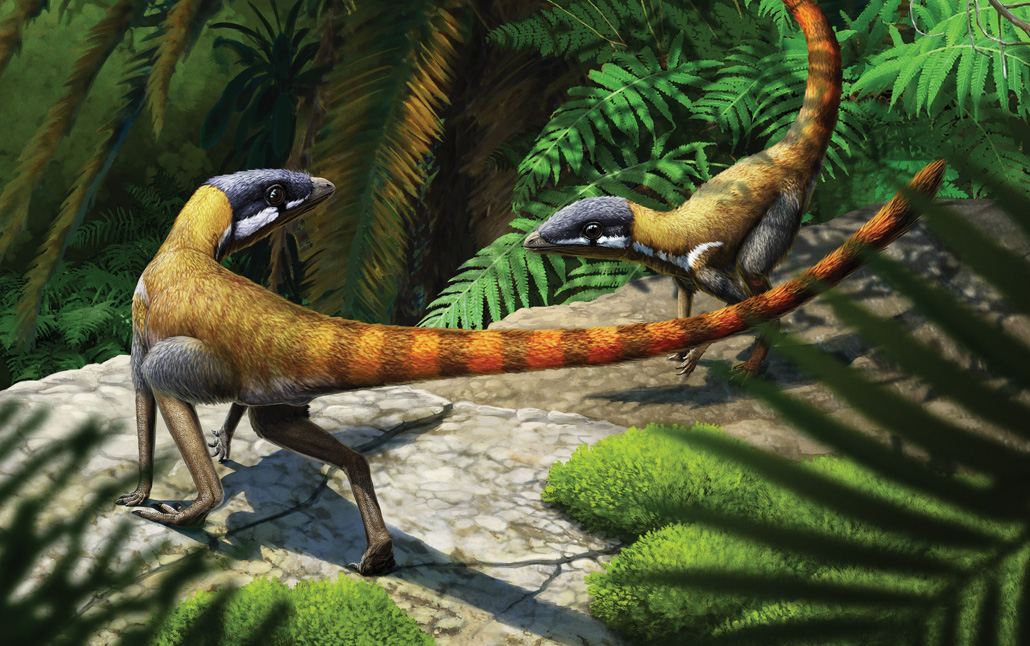This post was originally published on this site
In an eat-or-be-eaten world, flight conveys a bevy of benefits. A creature that takes to the third dimension can more easily escape earthbound predators, dine off a much broader menu or drop down on unsuspecting victims from above. Flying also allows an animal to cover distance more quickly, forage more efficiently and find mates more easily.
So it’s perhaps surprising that only three groups of vertebrates have ever evolved sustained, muscle-powered flight. Pterosaurs, Greek for “wing lizards,” arrived on the scene in the Triassic Period, perhaps as early as around 237 million years ago. These original vertebrate fliers preceded birds by at least 70 million years and bats by more than twice that.
What caused pterosaurs’ demise is clear: The same asteroid that wiped out the non-avian dinosaurs about 66 million years ago also took them out — along with more than 75 percent of all life on Earth (SN: 7/4/20 & 7/18/20, p. 10). But how pterosaurs took to the air in the first place remains a big mystery. “We don’t have any properly transitional fossils for pterosaurs, or at least ones that we recognize,” says Matthew Baron, a freelance vertebrate paleontologist.
Despite the gap in the early fossil record, recent research offers clues to who pterosaurs’ earliest cousins were and what they looked like, and how pterosaurs evolved from small, flitting creatures into an incredibly varied group. They eventually occupied ecosystems worldwide and consumed a wide variety of prey — getting bigger and spreading farther earlier than previously thought, recent studies reveal. Some grew bizarre crests atop their heads, while others sported mouths full of teeth that projected threateningly at various angles.
“Some pterosaurs looked like creatures from your nightmares,” says Brian Andres, a vertebrate paleontologist at the University of Sheffield in England.
During their lengthy reign of the skies, pterosaurs ranged in size from creatures that could sit in the palm of your hand to soaring behemoths with wingspans that rivaled those of an F-16 fighter jet. In fact, the largest animal that ever took flight — an iconic species discovered more than half a century ago but only recently described in great detail — was a pterosaur.
Where did pterosaurs come from?
Pterosaur fossils were first unearthed in the late 1700s — coincidentally, from the same limestone formation in Germany that later yielded the earliest known bird, Archaeopteryx. Scientists didn’t quite know what to make of the fossils. One scientist proposed they belonged to a weird sea creature, and another thought they represented a transitional form between birds and bats. But soon, experts settled on the fact that pterosaurs were flying reptiles, distinct from dinosaurs.
The first discovered species was named Pterodactylus antiquus, the genus name stemming from the Greek words for “wing finger.” (Although this species and many discovered soon after were commonly referred to as pterodactyls, that term officially applies only to this species and a small group of related species within the broader pterosaur lineage.) Unlike in bats, whose wing membranes are stretched between four elongated fingers of the hand, a pterosaur’s wing is supported by only one hyperelongated finger, a hallmark that helps distinguish pterosaurs from other creatures.
But something pterosaurs and bats do share is that when they first appear in the fossil record, they’re already able to fly. Direct evidence of how the reptiles took to the skies is lacking. “As yet, we do not know of any ‘missing link’ pterosaurs,” Baron reported in 2021 in Earth-Science Reviews.
The oldest known pterosaur fossils date to about 219 million years ago, though paleontologists suspect pterosaurs originated as early as 237 million years ago, Baron notes. That’s when the oldest and closest relatives of pterosaurs lived, and thus probably around the time that pterosaurs would have split off and formed their own lineage. The gap in the fossil record is in part due to the fact that rocks from this period are scarce worldwide. And many pterosaur bones were hollow, so they were vulnerable to being crushed soon after death or during fossilization. “Often, pterosaur remains are just a jumble of bones,” Baron says.
But there are indirect clues to what a proto-pterosaur might have looked like and whether pterosaur flight evolved from the ground up — in terrestrial creatures that flapped and leaped into the air — or from the trees down — in tree-living animals that glided.
Those clues come from studies of pterosaurs and their relatives. In 2020, researchers published a paper in Nature comparing the anatomy of 157 species of early pterosaurs, primitive dinosaurs and a variety of reptiles that lived at the same time or earlier. A group known as lagerpetids — from the Greek for “rabbit reptiles,” so named because of the general proportions of the bones in the limbs — was most closely related to pterosaurs.
A separate analysis, reported last year in Nature, showed that a fast-running, roughly 20-centimeter-long reptile that lived about 230 million years ago was a close relative of both lagerpetids and pterosaurs. Given that close relationship, this creature, called Scleromochlus taylori, may serve as a good stand-in for the kind of animal that pterosaurs evolved from (SN: 11/5/22, p. 15).
S. taylori had slender limbs, small hands and straight claws, all of which point to a ground-dwelling creature, says Davide Foffa, a vertebrate paleontologist at National Museums Scotland in Edinburgh. Because a critter like S. taylori presumably didn’t spend a lot of time in trees, that argues against the idea that pterosaur flight evolved out of gliding. But a small pelvic girdle suggests that S. taylori wasn’t a leaper, Foffa says. That would seem to argue against the standard idea for how a ground dweller would take to the skies. However, he says, “it’s not necessary to be a leaper to evolve flight.”

What did pterosaurs eat?
What pterosaurs ate is often a matter of conjecture. Although some fossils preserve stomach contents — direct evidence of what was consumed — most of the time researchers must look at where a pterosaur lived and how its anatomy compares with modern creatures to reconstruct diet. Based on such comparisons, researchers have speculated that various species of pterosaurs ate everything from insects and worms to fish, crustaceans and meatier prey such as small land vertebrates.
But sometimes, researchers are left to comb through other types of evidence.
Take Kunpengopterus sinensis, a pterosaur that lived in what is now China between 165 million and 153 million years ago. Last year, researchers reported unearthing fossils of this species alongside gastric pellets chock-full of fish scales, a strong hint that the creatures had eaten fish and then regurgitated the indigestible bits, as modern owls and gulls do (SN: 3/12/22, p. 5).
Other evidence comes à la fossilized poop — or, more delicately, coprolites. If a coprolite can be linked to the creature that made it, any contents can be reasonably identified as a part of the diet, says Martin Qvarnström, a vertebrate paleontologist at Uppsala University in Sweden. A few years ago, he and colleagues analyzed three coprolites from more than 150-million-year-old rocks unearthed in south-central Poland. The fossilized dung was deposited on an ancient tidal flat that also preserved a multitude of pterosaur footprints, Qvarnström says. The well-trampled surface appears to have been rapidly buried, perhaps as soon as the next tide came in, so it’s very likely that both the footprints and the coprolites were made by pterosaurs, he and colleagues reported in 2019 in PeerJ.
Using high-energy radiation to perform CT–like scans of the fossilized poop, the team found that the largest coprolite, which was about 1.5 centimeters long and 6 millimeters in diameter, contained more than 100 calcium-rich shells of single-celled organisms called foraminifera. One of the smaller coprolites contained many bristles from what may have been bottom-dwelling marine worms. The large numbers alone suggest that ingestion of these forams and worms wasn’t accidental, Qvarnström says. Instead, the researchers propose, the pterosaur had been targeting this prey.
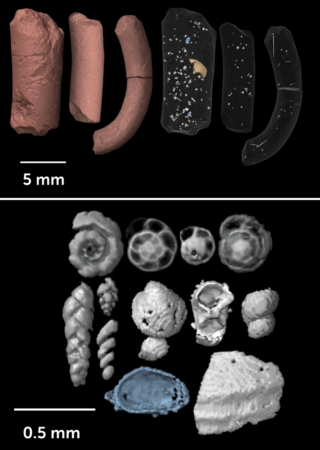
For these pterosaurs to consume such minuscule prey, they must have been filter feeders, much like flamingos or baleen whales. To capture the forams — which were mostly about 300 micrometers across, about the size of a large dust mite — these pterosaurs must have had jaws full of closely spaced teeth, the team suggests. Although filter-feeding pterosaurs are known from later ages, this is the first strong evidence for them living as early as about 150 million years ago, says Qvarnström.
Because skeletal fossils of these pterosaurs aren’t yet known, Qvarnström’s group doesn’t know what the mystery filter feeders looked like or how big they were. But maybe they resembled the newly discovered species Balaenognathus maeuseri. (Balaenognathus, roughly translated from Latin, means “whale jaw,” a reference to baleen whales.) Its fossils were unearthed from limestone rocks laid down as sediment sometime between 157 million and 152 million years ago in what is now Germany, says David Martill, a vertebrate paleontologist at the University of Portsmouth in England.
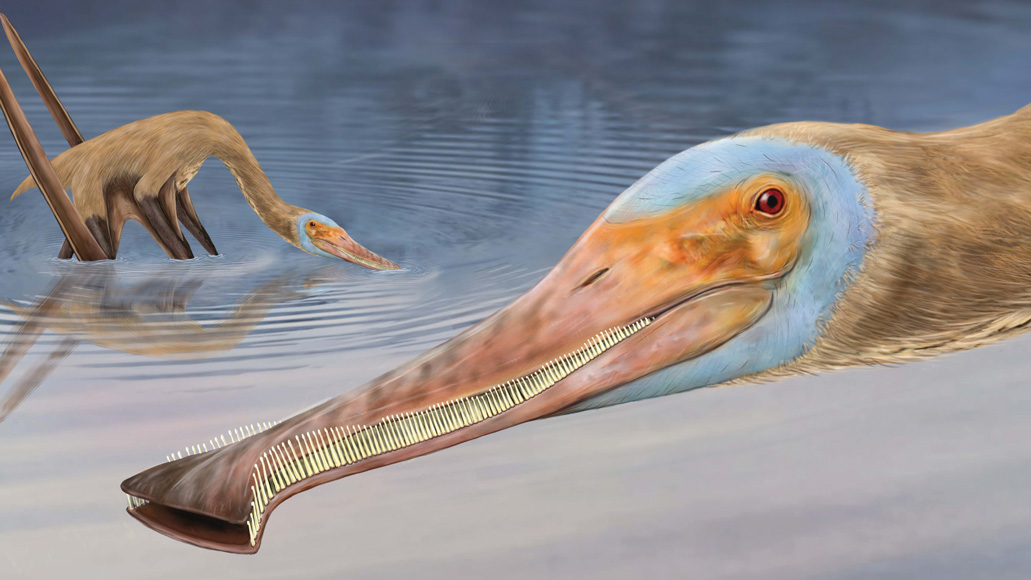
B. maeuseri had a wingspan of about 1.5 meters, similar to a large flamingo. The pterosaur had a 10-centimeter-long, spatula-shaped bill that sported at least 480 teeth. Many of those long, thin teeth — not strong enough to provide a clamping bite on struggling prey — had tiny hooks on their ends, Martill says. That’s unlike anything seen in any other pterosaur. The crochet hook–like features probably helped the pterosaur filter and trap itty-bitty prey more effectively than straight teeth would have, Martill and colleagues reported January 21 in PalZ. When foraging, this long-legged creature probably waded through shallow water, facing into the flow and opening its jaws just enough for plankton-rich water to enter, Martill says. Then, water drained away through the teeth, leaving behind a food-rich slurry.
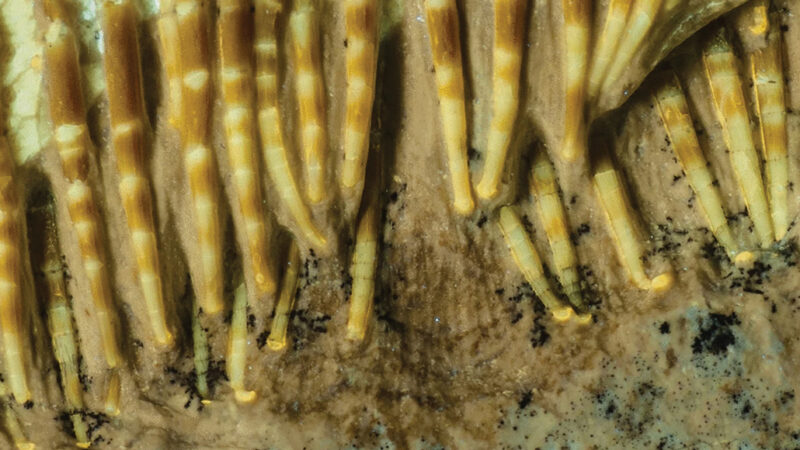
Growing large and going global
Thanks to a fossil discovered in 2017 on Scotland’s Isle of Skye, researchers now realize that pterosaurs grew to larger sizes much earlier than once thought. That, in turn, has helped debunk some theories about why pterosaurs evolved large body sizes.
Embedded in limestone laid down as sediments in a lagoon about 167 million years ago, the well-preserved fossil lacks only parts of the skull, wings, hind limbs and tail, says Natalia Jagielska, a vertebrate paleontologist at the University of Edinburgh. She and colleagues dubbed the creature Dearc sgiathanach, which in Scottish Gaelic means “winged reptile from Skye.”
Microscopic analyses of cross sections of some bones revealed features akin to the growth rings in trees, hinting that the pterosaur was at least 2 years old and still growing when it died, Jagielska and colleagues reported in February 2022 in Current Biology. Based on the size of the pterosaur’s upper-arm bone, the team estimates the youngster had a wingspan of around 2 meters.
Comparisons with the growth patterns of closely related pterosaurs suggest that an adult would have had a wingspan of at least 2.5 meters and possibly 3 meters or more. That makes D. sgiathanach the largest pterosaur to have lived up until that time, with a wingspan that rivaled a trumpeter swan’s.
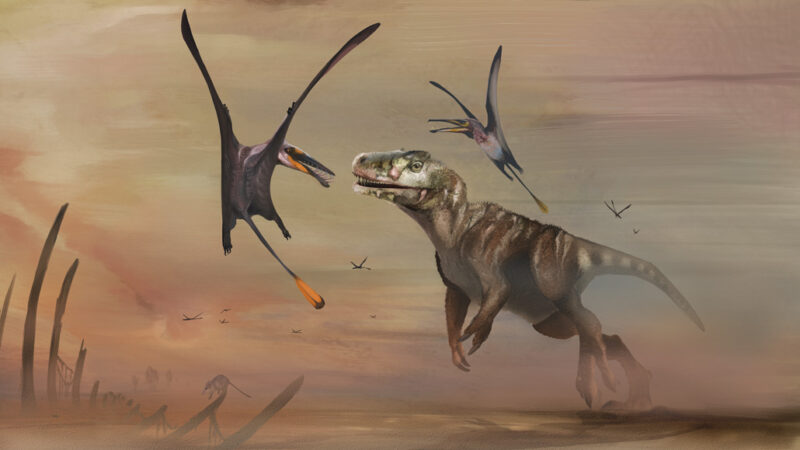
Before the discovery of D. sgiathanach, studies had suggested that pterosaurs didn’t start to become larger until the late Jurassic Period, between about 160 million and 145 million years ago. At that point, the story goes, competition with newly evolved birds forced pterosaurs to expand beyond being just insect eaters and into new ecological roles. But D. sgiathanach evolved tens of millions of years before the first birds took wing, so other, not-yet-identified factors must have been at play, the researchers say.
Another recent study speaks to how widely and how quickly pterosaurs spread around the world, Andres says. Some extremely fragmentary specimens unearthed from sandstone in northwestern Argentina, including scattered portions of a snout, a jawbone and a wing bone, are distinct enough to be classified as belonging to pterosaurs. The features are so distinct that Andres and colleagues named two brand-new species:Yelaphomte praderioi and Pachagnathus benitoi. The team described the fossils in March 2022 in Papers in Palaeontology.
The sandstone probably dates to sometime between 206 million and 200 million years ago, the researchers estimate. Unequivocal pterosaur remains known from that time come from North America, Europe and Greenland — all then part of the northwestern portions of the supercontinent Pangaea. The new fossils were found in an area that was once southwestern Pangaea, Andres notes. That reveals a wider distribution tens of millions of years earlier in pterosaur history than was previously presumed, Andres’ team argues. And because the sandstone formed in upland areas far from the nearest coast, the find reveals that pterosaurs lived in a greater diversity of habitats in this era than previously recognized.
The largest animal ever to fly
Of all the pterosaurs ever found, none has captured imaginations as much as Quetzalcoatlus northropi, the largest creature to ever take flight. Besides cameos in Jurassic Park: Dominion and the comic strip Calvin and Hobbes, the species has appeared on the postage stamps of more than two dozen nations and on two coins struck by the Royal Canadian Mint.
Scientists are enamored of the species too. The 1975 paper that initially described it has been cited more than 500 times, despite its brevity, Andres says. In late 2021, Andres and colleagues built on that paper’s description with a number of papers that, for the first time, delved deeply into the iconic species’ size, appearance, movements and the habitat where it lived.
Only a handful of Q. northropi fossils have been found, most in the Big Bend area of southwestern Texas, Andres says. Most of the identifiable remains come from a handful of creatures and together comprise a partial wing and a few leg bones. They, and several hundred other poorly preserved pterosaur bone fragments, were unearthed from rocks formed from sediments that accumulated in stream channels between 69 million and about 66 million years ago, says Tom Lehman, a vertebrate paleontologist at Texas Tech University in Lubbock. That means some of these pterosaurs could have been alive when or just before an asteroid struck Earth and brought on a long-lasting and worldwide climate catastrophe.
Much of what scientists suspect about Q. northropi stems from the more common fossils of a related species, Q. lawsoni. Andres and his colleagues have unearthed fossils of more than 200 of these individuals, offering enough bones to reconstruct the majority of the pterosaur. The team estimates that this smaller relative had a wingspan of about 4.5 meters and lived in the same area around the same time as Q. northropi, Lehman says. He and colleagues estimate that Q. northropi had a wingspan of about 10 meters.
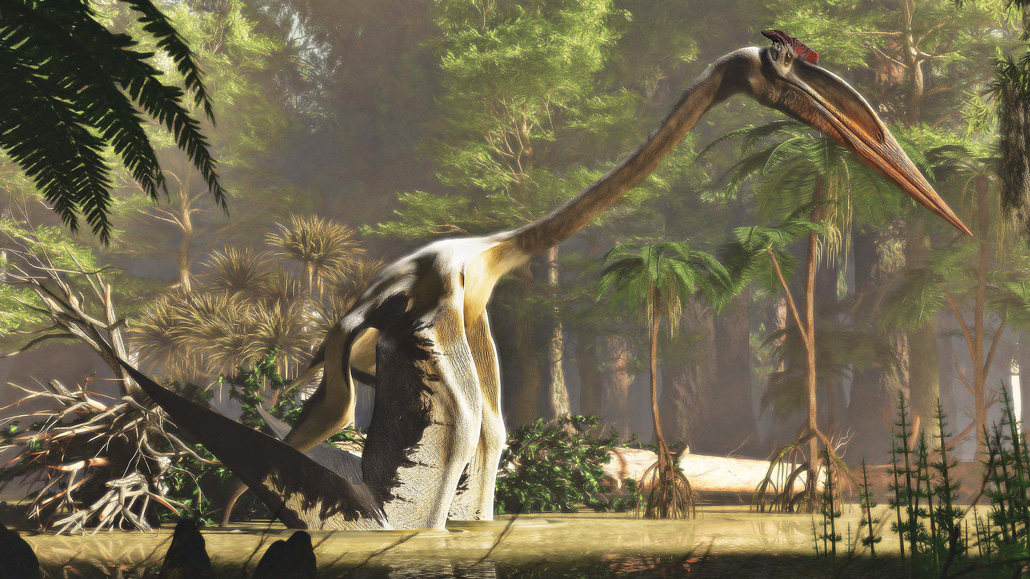
If these two species did live simultaneously, Lehman says, they evidently divvied up the ecosystem and foraged separately. When they died, their carcasses ended up in different types of sedimentary rocks, suggesting different parts of the environment. Q. lawsoni apparently spent a lot of time in oxbow lakes. Q. northropi, on the other hand, seems to have foraged along the edges of the river itself. Plenty of water snails and other creatures lived in these bodies of water and would have provided ample food for hungry pterosaurs and other predators, Lehman says.
Based on their measurements, the researchers made life-size models of Q. northropi’s bones to see how the creatures would have moved and to reconstruct the range of motion of their joints. “First of all, their back is so short and their legs are so long that they couldn’t walk like other quadrupeds,” says Kevin Padian, a vertebrate paleontologist at the University of California, Berkeley. “And their forelimbs are so long, they couldn’t avoid touching the ground.” Yet pterosaur footprints suggest that those forelimbs weren’t helping propel the creature forward when it walked, he says. Instead, they appear to have been used for support only, like walking sticks.
It appears that Quetzalcoatlus could reach down to the ground with its long, toothless beak — and even lower, into bodies of water. Once it grabbed its prey, it could tilt its beak to the sky and swallow its victims whole. So Padian and colleagues suggest that this pterosaur patrolled through meadows or waded in shallow waters as modern-day storks or herons do, plucking up fish, mammals or even small dinosaurs using a beak that acted like chopsticks.
The sight of a giraffe-sized predator stalking through swamps would have undoubtedly been impressive. “The worst thing about pterosaurs,” Andres says, “is that they’re no longer around.”
